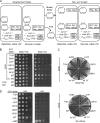Functional elements in initiation factors 1, 1A, and 2β discriminate against poor AUG context and non-AUG start codons
- PMID: 21930786
- PMCID: PMC3232919
- DOI: 10.1128/MCB.05819-11
Functional elements in initiation factors 1, 1A, and 2β discriminate against poor AUG context and non-AUG start codons
Abstract
Yeast eIF1 inhibits initiation at non-AUG triplets, but it was unknown whether it also discriminates against AUGs in suboptimal context. As in other eukaryotes, the yeast gene encoding eIF1 (SUI1) contains an AUG in poor context, which could underlie translational autoregulation. Previously, eIF1 mutations were identified that increase initiation at UUG codons (Sui(-) phenotype), and we obtained mutations with the opposite phenotype of suppressing UUG initiation (Ssu(-) phenotype). Remarkably, Sui(-) mutations in eukaryotic translation initiation factor 1 (eIF1), eIF1A, and eIF2β all increase SUI1 expression in a manner diminished by introducing the optimal context at the SUI1 AUG, whereas Ssu(-) mutations in eIF1 and eIF1A decrease SUI1 expression with the native, but not optimal, context present. Therefore, discrimination against weak context depends on specific residues in eIFs 1, 1A, and 2β that also impede selection of non-AUGs, suggesting that context nucleotides and AUG act coordinately to stabilize the preinitiation complex. Although eIF1 autoregulates by discriminating against poor context in yeast and mammals, this mechanism does not prevent eIF1 overproduction in yeast, accounting for the hyperaccuracy phenotype afforded by SUI1 overexpression.
Figures









References
-
- Algire M. A., Maag D., Lorsch J. R. 2005. Pi release from eIF2, not GTP hydrolysis, is the step controlled by start-site selection during eukaryotic translation initiation. Mol. Cell 20: 251–262 - PubMed
-
- Boeke J. D., Trueheart J., Natsoulis G., Fink G. R. 1987. 5-fluoroorotic acid as a selective agent in yeast molecular genetics. Methods Enzymol. 154: 164–175 - PubMed
-
- Bushman J. L., Foiani M., Cigan A. M., Paddon C. J., Hinnebusch A. G. 1993. Guanine nucleotide exchange factor for eIF-2 in yeast: genetic and biochemical analysis of interactions between essential subunits GCD2, GCD6, and GCD7 and regulatory subunit GCN3. Mol. Cell. Biol. 13: 4618–4631 - PMC - PubMed
-
- Butler J. S., Springer M., Dondon J., Graffe M., Grunberg-Manago M. 1986. Escherichia coli protein synthesis initiation factor IF3 controls its own gene expression at the translational level in vivo. J. Mol. Biol. 192: 767–780 - PubMed
Publication types
MeSH terms
Substances
Grants and funding
LinkOut - more resources
Full Text Sources
Molecular Biology Databases
Research Materials
